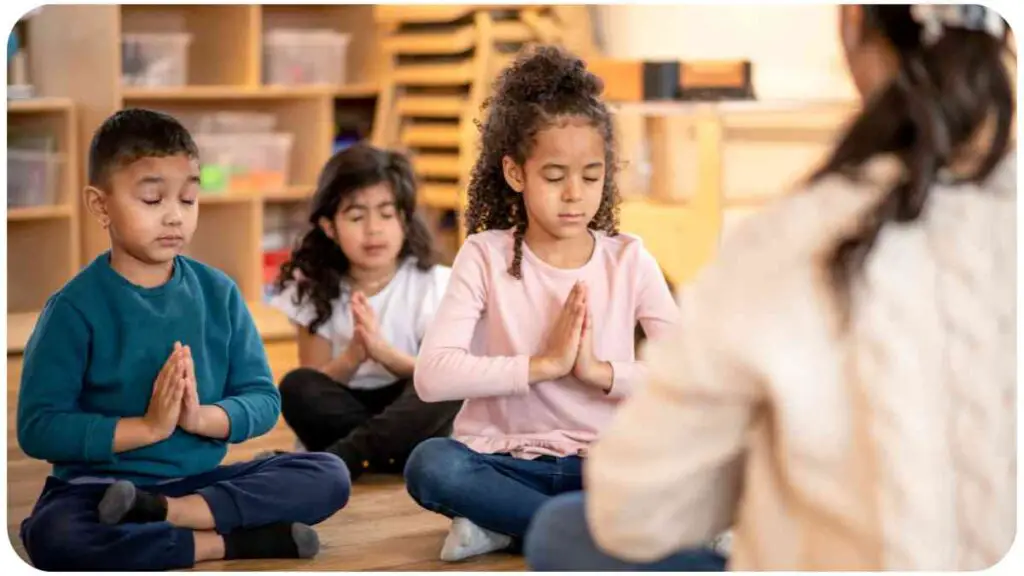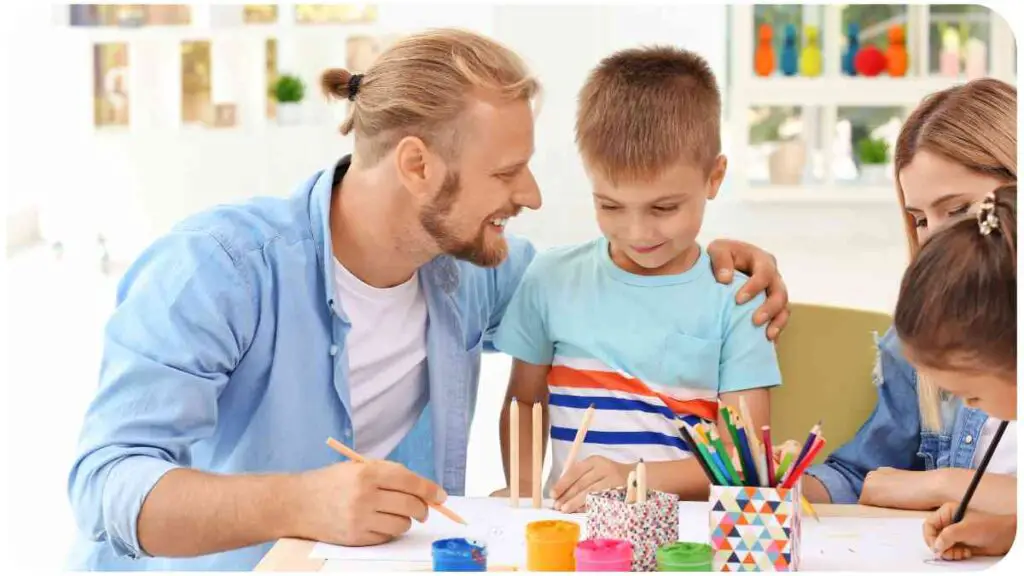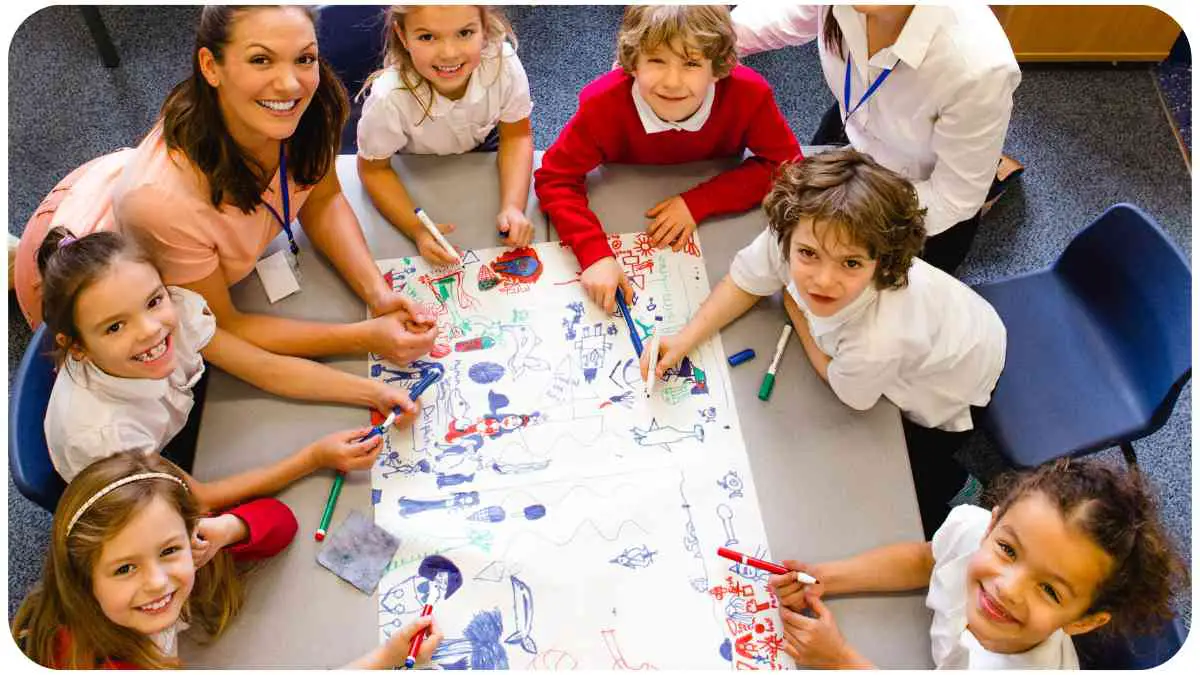Welcome to the world of creative visualizations for young yogis! In this article, we’ll explore the transformative power of visualization techniques tailored specifically for children.
Whether you’re a parent, teacher, or yoga instructor, unlocking the potential of creative visualization can bring a new dimension to a child’s yoga practice.
| Takeaway |
|---|
| Creative visualizations for kid yogis offer a transformative journey, promoting focus, relaxation, and imagination. |
| New Moon energies provide a unique opportunity for setting intentions and engaging children in visualization exercises. |
| A kid-friendly yoga space, imaginative themes, and engaging tools enhance the effectiveness of creative visualizations. |
| Guided visualization scripts, tailored to themes like enchanted forests and cosmic journeys, capture young minds’ imaginations. |
| Incorporating fun activities, expert insights, and success stories make the practice enjoyable and beneficial for child development. |
| Tips for parents and instructors, along with FAQs, provide guidance for seamlessly integrating creative visualizations into kids’ routines. |
2. The Power of Creative Visualization for Kids
Creative visualization is a powerful tool that allows children to harness their imagination for positive outcomes. It helps them develop focus, reduce stress, and enhance their overall well-being. As we delve into this topic, let’s uncover the myriad benefits awaiting young minds.
Guide young minds to serenity with calming meditations. Help kids find peace within through mindful relaxation practices designed for their unique needs.
3. Understanding New Moon Energies
Before we embark on our journey of creative visualizations, let’s take a moment to understand the significance of New Moon energies. This celestial phase offers a unique opportunity for setting intentions and embracing new beginnings, making it an ideal time for kid yogis to engage in visualization exercises.
4. Setting the Stage: Creating a Kid-Friendly Space
Essential Elements for a Kid-Friendly Yoga Space
| Element | Description |
|---|---|
| Playful Decor | Bright colors, whimsical themes |
| Comfortable Mats | Soft and non-slip surfaces |
| Imaginative Props | Puppets, soft toys, and themed accessories |
| Calming Scents | Lavender or chamomile scents for relaxation |
Creating a conducive environment is crucial for the success of creative visualizations. Ensure your kid-friendly yoga space incorporates these essential elements.
5. Guided Imagery for Young Minds

Visualization Themes and Benefits
| Theme | Benefits |
|---|---|
| Enchanted Forest | Sparks imagination, fosters a sense of adventure |
| Cosmic Journey | Enhances awareness of the universe |
| Animal Safari | Promotes physical movement and connection with nature |
| Magic Garden | Encourages creativity and growth |
Choosing the right visualization theme is key to captivating young minds. Each theme offers unique benefits, contributing to the holistic development of the child.
Foster self-compassion in children with short meditations. Cultivate a sense of kindness and understanding through brief, engaging meditation sessions tailored to young hearts.
6. Crafting Engaging Visualizations
Sample Visualization Script for Kids
| Stage | Script |
|---|---|
| Relaxation | “Imagine you’re lying on a soft cloud, floating in the sky.” |
| Setting the Scene | “Picture a magical forest with colorful flowers and talking animals.” |
| Interactive Elements | “As you explore, meet a wise owl who shares a special secret with you.” |
| Resolution | “Now, slowly bring your awareness back, feeling refreshed and calm.” |
Crafting a visualization script involves guiding children through stages that capture their imagination and promote relaxation. Adjust the script based on the chosen theme.
7. Tools and Props for Kid-Friendly Visualizations
Recommended Tools and Props
| Tool/Prop | Purpose |
|---|---|
| Imaginary Binoculars | Enhances focus on distant elements in visualizations |
| Soft Blankets | Provides comfort and warmth during relaxation |
| Storybooks | Inspires visualization themes and storytelling |
| Glitter Jars | Creates a mesmerizing visual focus for calming exercises |
Incorporating tools and props adds a tactile and sensory dimension to visualizations, making them more engaging for kids.
8. Navigating Challenges: Common Concerns and Solutions
Common Challenges and Solutions
| Challenge | Solution |
|---|---|
| Restlessness | Introduce movement within visualizations |
| Distractions | Use interactive elements to maintain focus |
| Fear or Anxiety | Choose gentle and reassuring visualization themes |
| Lack of Interest | Tailor visualizations to the child’s interests |
Addressing common challenges ensures a smoother experience during visualization sessions. Adapt strategies based on individual needs.
Bring the joy of yoga to kids without mats through free home flows. Explore simple yet effective yoga sequences designed for children to practice comfortably at home.
9. Incorporating Fun: Games and Activities

Fun Activities to Enhance Visualizations
| Activity | Description |
|---|---|
| Mindful Drawing | Encourage children to draw their visualizations |
| Freeze and Imagine | Pause and ask kids to visualize while staying still |
| Musical Visualization | Use music to enhance the atmosphere of visualizations |
| Storytelling Relay | Collaborative storytelling with each child adding to the narrative |
Making visualizations fun ensures that kids remain engaged and excited about the practice. These activities add an interactive and enjoyable dimension.
10. The Impact of Visualization on Child Development
Developmental Milestones Enhanced by Visualization
| Milestone | Visualization Impact |
|---|---|
| Cognitive Skills | Improved focus, enhanced creativity |
| Emotional Regulation | Stress reduction, increased self-awareness |
| Social Interaction | Collaborative activities promote teamwork |
| Physical Well-being | Calming visualizations contribute to overall wellness |
Understanding how visualization aligns with developmental milestones helps reinforce the importance of these practices for child growth.
11. Expert Insights: Voices in the Field
As a seasoned practitioner, I’ve had the privilege of learning from experts in the field of child psychology and yoga. Dr. Emily Thompson, a renowned child psychologist, emphasizes the importance of creative visualization in fostering emotional resilience and cognitive development in children.
Dr. Thompson suggests, “Creative visualization offers children a safe space to explore their emotions and imagination, laying the foundation for strong mental well-being.”
Ignite imagination with cosmic yoga adventures. Transport young minds to fantastical realms through yoga practices that blend physical activity with imaginative storytelling for an enriching experience.
12. Success Stories: Transformative Experiences
Real-life examples demonstrate the profound impact of creative visualizations on young minds. Take the case of Sarah, a 7-year-old who struggled with anxiety. Through guided visualizations, she learned to manage her emotions and express herself confidently.
Sarah’s story is a testament to the transformative power of visualization, showcasing its potential to positively influence children facing challenges.
13. Tips for Parents and Instructors
As you embark on incorporating creative visualizations into your child’s routine, or if you’re an instructor guiding young yogis, consider the following tips:
- Start with Short Sessions: Begin with brief visualization sessions and gradually extend the duration as children become more comfortable with the practice.
- Encourage Expression: Create a safe space for children to share their experiences or drawings after a visualization. This fosters open communication and creativity.
- Be Flexible with Themes: Tailor visualizations to the interests of the child. Whether it’s outer space adventures or underwater exploration, adapt themes to captivate their imagination.
- Use Gentle Guidance: Maintain a soothing and calm voice while guiding visualizations. The goal is to create a relaxing atmosphere for the child’s mind to wander.
- Combine Visualizations with Yoga Poses: Integrate simple yoga poses into the visualization process. This adds a physical element and enhances the mind-body connection.
Ease children’s stress with soothing chair yoga poses. Transform ordinary chairs into tools of relaxation, teaching kids how to find tranquility and mindfulness in simple, accessible movements.
14. Frequently Asked Questions (FAQs)
Top FAQs About Creative Visualization for Kids
| Question | Answer |
|---|---|
| How often should we practice visualizations? | Aim for 5-10 minutes, 2-3 times a week to start. |
| Can visualizations help with sleep issues? | Yes, calming visualizations before bedtime can promote better sleep. |
| Is there an age limit for creative visualizations? | Generally suitable for kids aged 5 and above, but adapt based on individual readiness. |
| Can visualizations replace traditional meditation? | They complement each other; visualizations add an imaginative aspect to meditation for children. |
Answering common questions helps parents and instructors navigate the world of creative visualization with confidence.
15. Conclusion
In conclusion, introducing creative visualizations to kid yogis can be a delightful and enriching experience. The combination of imaginative storytelling, themed visualizations, and expert insights creates a holistic approach to child development. By incorporating these practices, we empower children to navigate their inner worlds with resilience and joy, guiding them from the new moon and back.
Feel free to share your experiences with creative visualizations for kids and continue exploring the wonders they bring to young minds.
Further Reading
Explore these additional resources to deepen your understanding of creative visualizations for kid yogis:
- HeartSoundsYoga: Guided Visualization – The Moon Walk: This insightful article provides a guided visualization technique, “The Moon Walk,” offering a unique perspective on incorporating lunar energy into children’s practices.
- Everand: Sweet Dreams – Bedtime Visualizations for Kids: Delve into this book for a collection of bedtime visualizations designed specifically for kids, promoting relaxation and peaceful sleep.
- DrYogaMomma: 14-Day New Moon Practice Sadhana: Dr. Yoga Momma shares a 14-day practice sadhana centered around the new moon, offering a comprehensive approach to aligning yoga practices with lunar phases.
FAQs
What are the recommended ages for introducing creative visualizations to kids?
Creative visualizations are generally suitable for kids aged 5 and above. However, adapt the practice based on the individual readiness and interests of the child.
How often should we incorporate creative visualizations into a child’s routine?
Start with short sessions of 5-10 minutes, 2-3 times a week. Gradually extend the duration as children become more comfortable with the practice.
Can creative visualizations help children with sleep issues?
Yes, calming visualizations before bedtime can contribute to better sleep by creating a relaxing and soothing atmosphere.
Is there a specific theme that works best for all children during visualizations?
Themes should be tailored to the interests of the child. Whether it’s outer space adventures or underwater exploration, adapting themes captivates their imagination.
How do creative visualizations impact a child’s overall development?
Creative visualizations positively influence cognitive skills, emotional regulation, social interaction, and physical well-being. The practice contributes to improved focus, enhanced creativity, stress reduction, and overall wellness.

Hello, my name is Hellen James! I am a yoga teacher and writer who loves to share information about how you can achieve a more fulfilling life. I have been practicing mindfulness, yoga, and meditation for over 10 years. My passion for these practices has led me to teach them to others.

